The Meaning of Altar
Understanding the Spiritual Significance
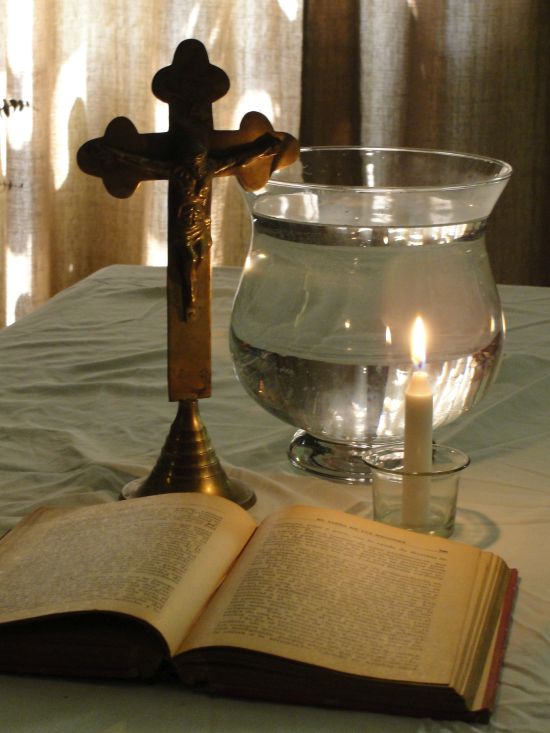 the meaning of altar
the meaning of altarThe Meaning of Altar
A Gateway to the Divine
What is a Spiritual Altar?
Throughout history, man has had an inner need to establish a connection with God and the spiritual realm. In his quest to satisfy this inner need, the concept of an altar was created.
Altar bible meaning: "In the Bible, an altar is a raised structure in a place of worship where people make offerings to God." (Google)
Abraham built the first altar to express his complete dedication to God, marking a significant milestone in his faith journey. He continued to build an altar to God at each place he and his family lived.
Solomon built a cedar altar in his temple dedicated to God where he burnt offering.
Solomon’s temple had a cedar altar dedicated to God, where he burned offerings.
Altars, such as the altar of incense, were made of acacia wood and overlaid with gold, highlighting their significance in ancient sacrificial practices and the design of religious structures.
Modern churches have altars that are sacred places for rituals and worshipping of God. The altar consists of a communion table.
A spiritual altar is a sacred space where individuals can connect with God, spirit messengers, and their higher selves. It serves as a focal point for reflection, and spiritual growth, where one can offer prayers, intentions, and gratitude to the Divine. The spiritual altar serves as a bridge between the physical and spiritual realms, allowing individuals to cultivate a deeper sense of spirituality and connection with the Divine. In many spiritual traditions, the altar is considered a portal to the spiritual realm, where one can communicate with spirit guides, angels, and other divine beings.
Whether it’s a small table or an end table adorned with candles and incense or a more elaborate setup with statues and sacred texts, the essence of a spiritual altar lies in its ability to provide a sanctuary for the soul. This personal space becomes a haven where one can retreat from the chaos of daily life and find solace in the presence of the Divine.
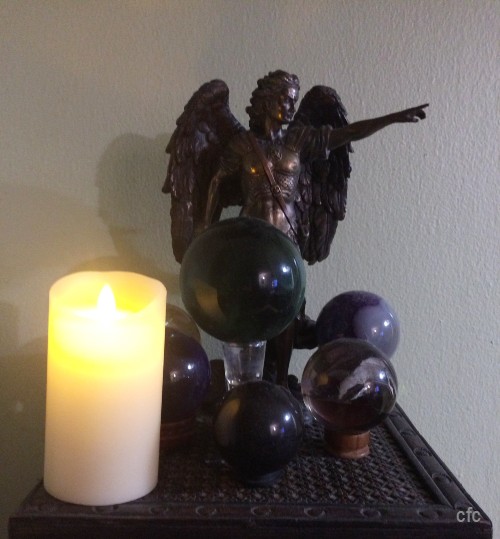
Spiritual Altar -Holy Place
Threshold between Physical and Spiritual Worlds
A spiritual altar is a holy place or space that represents a symbolic threshold between the physical and spiritual realms, where individuals can transcend their mundane concerns and connect with the sacred. It embodies the idea of sacrifice, surrender, and devotion, inviting individuals to let go of their egos and limitations and to open themselves to the Divine. Just as the ancient Israelites offered burnt offerings on the brazen altar in the temple courtyard, modern spiritual practitioners use their altars to present their own gifts sacred to the Divine. This act of creating and maintaining an altar is the ultimate way to honor and commune with the Higher Power that guides and sustains us.
The energy of God appeared to individuals, leading to deep commitments and personal transformations, much like Abraham's experience. This divine encounter motivates believers to consecrate themselves entirely to Him, symbolically building an altar of personal sacrifice and devotion.
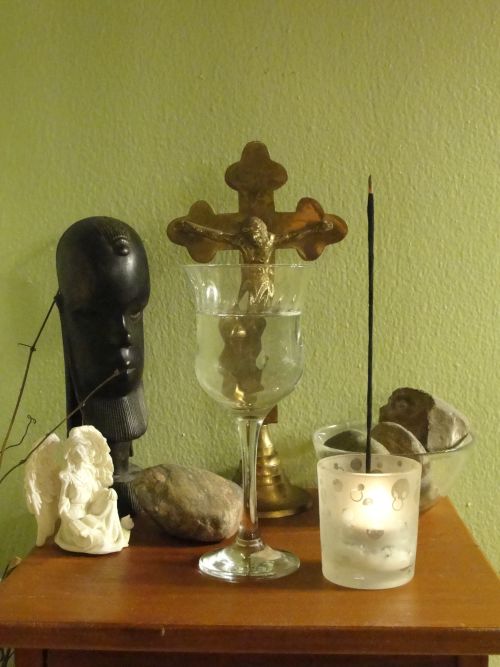
Types of Spiritual Altars
In biblical times, one type of spiritual altar was the "golden altar," also known as the "altar of incense." This altar was located within the Holy Place of the Tabernacle, where priests would burn incense to symbolically represent the prayers of the people ascending to God. It was constructed from acacia wood and entirely overlaid with gold, featuring horns on each corner. The altar offered a continual fragrant smoke to the Lord both day and night. (Google)
 gold altar or altar of incense by Tai
gold altar or altar of incense by TaiVarious types of spiritual altars, each with distinct characteristics and purposes, utilized in modern times are:
- Meditation Altar: A quiet space for contemplation, reflection, and mindfulness practices. This type of altar often includes items that promote peace and tranquility, such as candles, incense, and stones. Essential oils are also used.
- Prayer Altar: A sacred space for offering prayers, intentions, and gratitude to a Higher Power. It may feature religious icons/pictures such as Jesus Christ, sacred texts, and other items that hold spiritual significance.
- Ritual Altar: A space for performing sacred rituals, ceremonies, and sacraments. This altar is often more elaborate, with specific tools and elements needed for various spiritual practices.
- Ancestor Altar: A space for honoring and connecting with ancestors and loved ones who have passed on. This type of altar typically includes photos, mementos, and offerings that pay tribute to those who have gone before us.
 ancestor altar by Tai
ancestor altar by TaiEach type of altar is a sacred space that serves a distinct purpose, yet all share the common goal of fostering a deeper connection with the Divine and the spiritual realm.
Ancient altars, such as the altar of burnt offerings and the altar of incense, play a crucial role in various spiritual traditions, emphasizing their importance in worship practices.
The Function of a Spiritual Altar
The primary function of a spiritual altar is to facilitate a deeper connection with the Divine, oneself, spirits of light and others.
In the Catholic Church, the altar is represented by the Cross of Calvary, where the ultimate sacrifice was made, reconciling humanity with God and offering the promise of eternal life.
A Buddha altar is a focal point for Buddhist rituals and a place for deep contemplation. It's meant to help people develop the Buddha's qualities in themselves.
All altars share the following functions:
- Sacred Space for Worship, Prayer, Spiritual Practice, and Meditation: A place where individuals can focus their spiritual energy and engage in practices that nurture their souls and receive good energy.
- Symbolic Threshold Between the Physical and Spiritual Realms: An altar acts as a bridge, allowing individuals to transcend their everyday concerns and connect with the sacred.
- Focal Point for Spiritual Growth, Reflection, and Transformation: By regularly engaging with their altar, individuals can cultivate a deeper sense of spirituality and personal growth.
- Space for Spiritual Work, Offering Gratitude, Intentions, and Prayers: An altar provides a dedicated space for expressing thanks, setting intentions, and seeking guidance from the divine.
- A reminder of the Sacred and the Divine: The presence of an altar in one’s home serves as a constant reminder of the spiritual aspects of life and the importance of maintaining a connection with the divine.
Design and Elements of a Spiritual Altar
Creating a spiritual altar involves selecting items that resonate with your spiritual experience and placing them with intention and reverence. These could include candles, incense, sacred texts, and personal mementos. Arranging these items can be a meditative process, helping to center your thoughts and focus your spiritual energy. Whether you are seeking guidance, offering thanks, or simply spending time in quiet reflection, your spiritual altar can be a powerful tool for deepening your connection with the divine.
A spiritual altar can be designed and created with various elements, including:
- Sacred Objects: Statues, icons, a particular stone or relics that hold spiritual significance. These items serve as focal points for worship and reflection.
- Candles, Incense, and Other Sensory Elements: These elements help create a sacred atmosphere and can enhance the spiritual experience. The use of incense on an incense altar, for example, can symbolize the prayers rising to the heavens.
- Natural Elements: Plants, stones, or water that represent the natural world and its connection to the divine. These elements can ground the altar and bring a sense of harmony.
- Symbolic Objects: Crosses, mandalas, prayer beads or other sacred symbols that hold personal or religious significance. These items can serve as reminders of one’s faith and spiritual journey.
- Personal Items: Photos, mementos, or heirlooms that hold personal meaning. Including these items can make the altar more personal and reflective of one’s unique spiritual path. This can also include tarot or oracle cards.
- Sacred Texts: Scriptures, prayers, or poetry that inspire and guide one’s spiritual practice. These texts can provide wisdom and insight during times of reflection and meditation.
I remember a woman who had a Saint George's sword plant near her altar. She mentioned that the plant was believed to absorb negative energy.
The design and elements of a spiritual altar should reflect the individual’s personal beliefs, values, and spiritual practices, and should be created with intention, reverence, and respect. Whether it’s a simple set up with a few meaningful items or a more elaborate arrangement, the key is to create a space that resonates with your soul and supports your spiritual journey.
Remember, intention setting is primary.
Purpose of Burnt Offerings
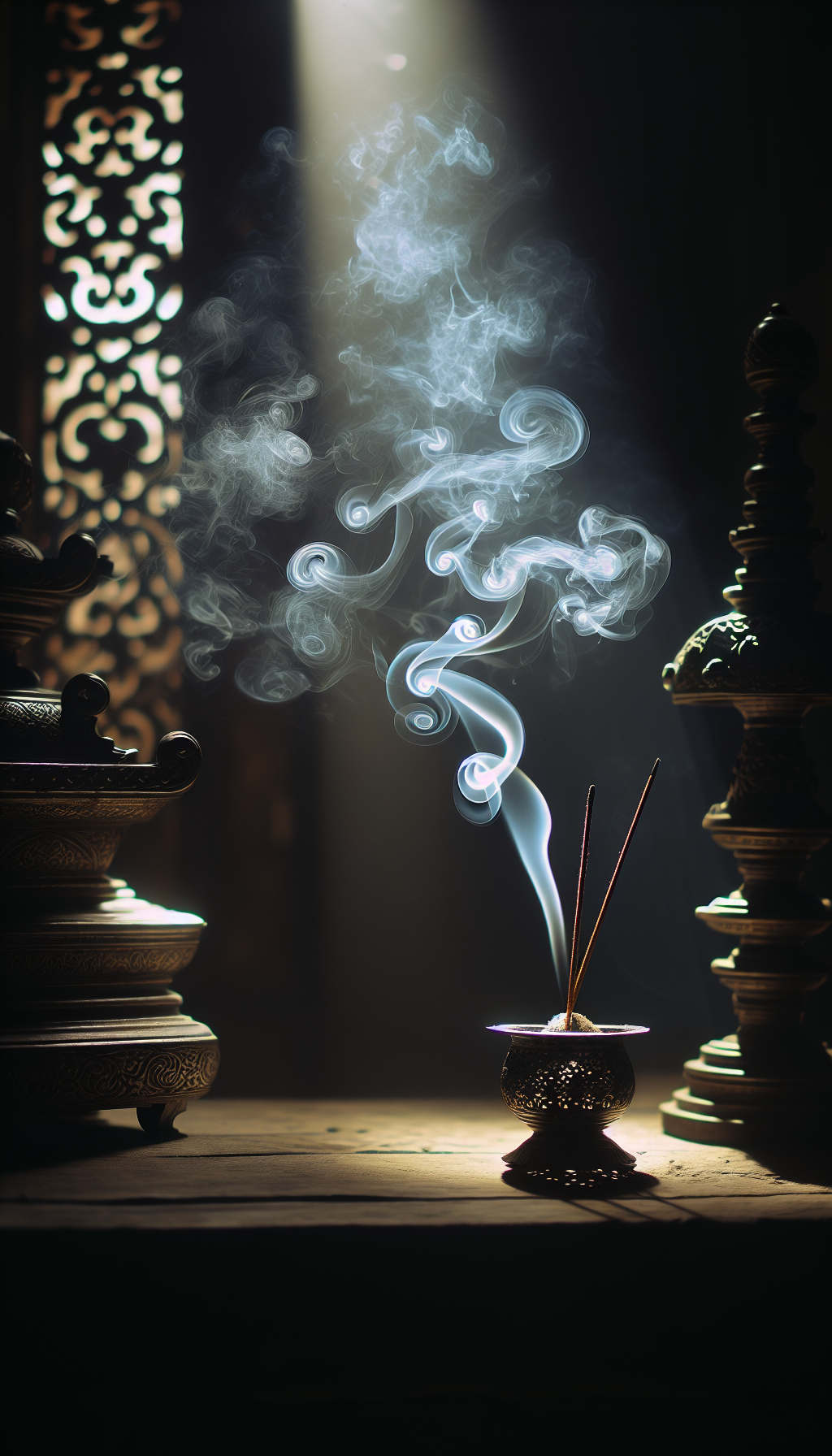 burnt offering by Tai
burnt offering by TaiBurnt offerings have been an integral part of spiritual practices across various cultures and traditions. In ancient times, burnt offerings were made to appease gods and goddesses, seeking their favor, protection, and blessings. The act of burning offerings symbolized the release of negative energies, emotions, and thoughts, making way for spiritual growth and renewal. In modern spiritual practices, burnt offerings are used to purify and consecrate a space, to release attachment to material possessions, and to offer gratitude to the divine. The smoke from the burnt offerings is believed to carry prayers and intentions to the spiritual realm, facilitating communication with spirit messengers and the divine.
Incorporating burnt offerings into your spiritual practice can be a powerful way to cleanse your space and mind. Whether you are burning herbs, incense, or other sacred items, the ritual can help you let go of what no longer serves you and invite positive energy into your life. As you watch the smoke rise, you can visualize your prayers and intentions being carried to the heavens, knowing that you are connecting with a higher power.
The Benefits of Having a Spiritual Altar
Having a spiritual altar can bring numerous benefits to one’s spiritual journey. It provides a dedicated space for spiritual practice, allowing individuals to focus their intentions, prayers, and meditation. The altar serves as a reminder of one’s spiritual commitments and goals, inspiring discipline and dedication. The act of creating and maintaining an altar can also foster a sense of connection to the divine, promoting feelings of peace, calmness, and inner peace. Moreover, the altar can become a symbol of one’s spiritual identity, reflecting their values, beliefs, and aspirations. By having a spiritual altar, individuals can deepen their spiritual practice, cultivate a stronger connection with the divine, and navigate life’s challenges with greater ease and clarity.
Your spiritual altar can be a sanctuary where you retreat from the chaos of daily life. It can be a place where you find solace, strength, and inspiration. By regularly engaging with your altar, you can create a routine that supports your spiritual growth and helps you stay aligned with your higher purpose. Whether you are seeking guidance, offering gratitude, or simply spending time in quiet reflection, your spiritual altar can be a powerful tool for nurturing your soul and enhancing your connection with the divine.
My Personal Experience
I grew up in a spiritual community where altars were common. I remember visiting my mother’s friends and family and seeing altars of various sizes; they all served the same purpose—a connection to the spirit world.
When I reached a certain age, I created my own spiritual altar, which was simply a replica of what I had seen before. As I began to develop spiritually and connect with my spirit guides, a new perspective started to unfold. With the assistance of a spirit guide, I was able to delve deeper into the true meaning of a spiritual altar.
I learned that an altar is very personal and should reflect the essence of a person’s spiritual development, with God at the center of all.
My altar is where I go whenever I face a situation beyond my control. It is also where I pray for others who need spiritual help. Whenever I am at my altar, I feel the presence and positive energy of my spirit guides surrounding me.
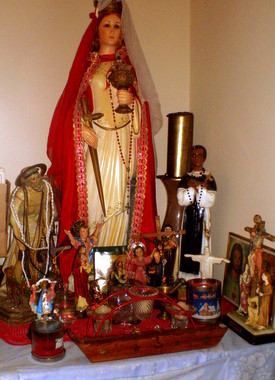 Espiritismo Altar
Espiritismo Altar
When placing an item on an altar, it's important to understand its purpose and to be aware of the energy surrounding the altar.
Some items, such as crystals, can enhance energy levels. Certain spirits may suggest using one or two crystals on the altar, but not all altars require them; it ultimately depends on what a person's guides feel is necessary.
For example, one woman shared that she keeps both rose quartz and clear quartz on her altar to promote spiritual love and strength. They were tools she used in her spiritual work.
Many people also include statues of saints on their altars, praying to these saints and expressing gratitude for the blessings they have received.
It is essential to recognize that no saint or spirit can fulfill requests without the permission of God. Therefore, it is advisable to place a symbol representing God in the center of the altar.
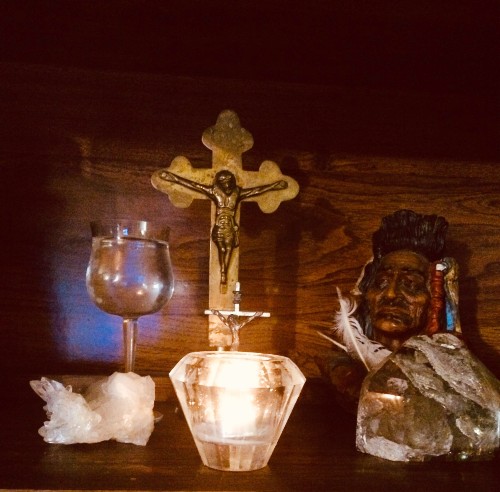 Christ and Indian Spirit Guide
Christ and Indian Spirit Guide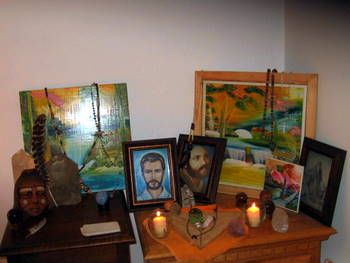
When I asked one of the individuals, who submitted a picture of her altar, about the purpose of her altar, she revealed the following:
“My altar is composed of saints who have great meaning to me. They are saints whom I prayed to when I was experiencing problems. Moreover, it is the place I go to whenever I require strength. There, I can relax and see things clearly. Also, it is my sacred place where I connect with my loved ones who have crossed over to the spirit world.
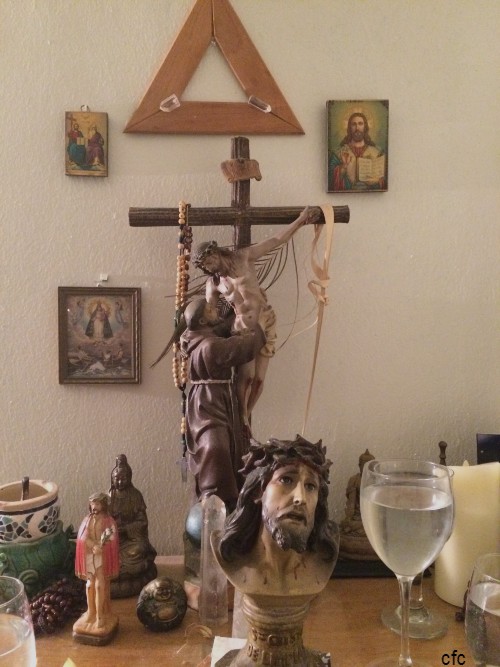
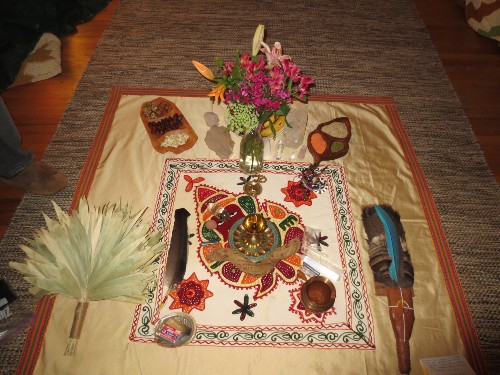 Ayahuasca Ceremonial Altar
Ayahuasca Ceremonial Altar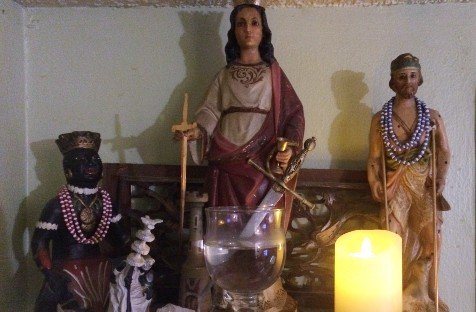 Chango, Saint Barbara and San Lazaro
Chango, Saint Barbara and San LazaroIn Santeria, an altar is called boveda. A boveda is usually a small table with a white tablecloth over it. Seven or nine goblets of water are placed on top. The largest one is in the middle and dedicated to the person's main spirit guide.
In the book Santeria- The Religion, Megene Gonzalez-Wippler writes that practitioners of Santeria, "believe that whenever a goblet fills with air bubbles, it is an indication that there are spiritual entities- often of a negative nature- in the vicinity. The water therefore acts as a kind of spiritual cleansing and as a subtle 'trap' for impure spirits."
In Jambalaya by Luisah Teish, she gives a guideline for building a small altar. A piece of white cloth, a crystal, chalice filled with water with a tablespoon of anisette, white rum, or white wine (this water is called spirit water), a white candle, four stones, and pictures of ancestors are items needed to create an altar.
In the Umbanda religion, an altar consists of the following essential elements: fire, earth, water, and air. During a recent Umbanda ceremony, the person in charge explained the various items on the temple's altar. There were three candles representing the fire element, each dedicated to specific orishas. I remember one was for Oshun, the Goddess of Rivers and Love. In front of the candles was a glass of water, representing the water element, which is believed to clear and take in all negative energy. A rock was located in front of the glass of water, symbolizing the earth element. Since orishas are earth spirits, having an item representing the earth is considered essential. The air element is self-explanatory.
Additional items were placed on this specific altar, including a small statue representing the temple's main spirit guide, flowers, and a solid white substance resembling chalk called cascarilla. Cascarilla is made from powdered eggshells. Mediums channeling spirits used cascarilla to inscribe their names on the ground. In certain spiritual traditions, cascarilla is utilized in spiritual practice -ritual.
Whatever kind of altar you have or are in the process of creating, it is important to remember that LOVE is the main ingredient.
Spiritual Practice: Cleanse your altar- sacred place - regularly using holy water, Florida water, sage, palo santo, essential oils, or whatever is best for you.
Do burnt offerings (incense) to cleanse and get rid of negative energy.
You decide what is best for you.
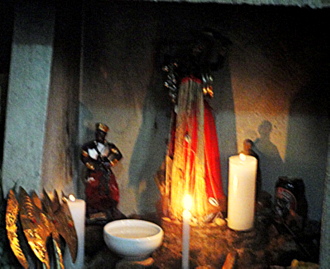 Umbanda Altar
Umbanda Altar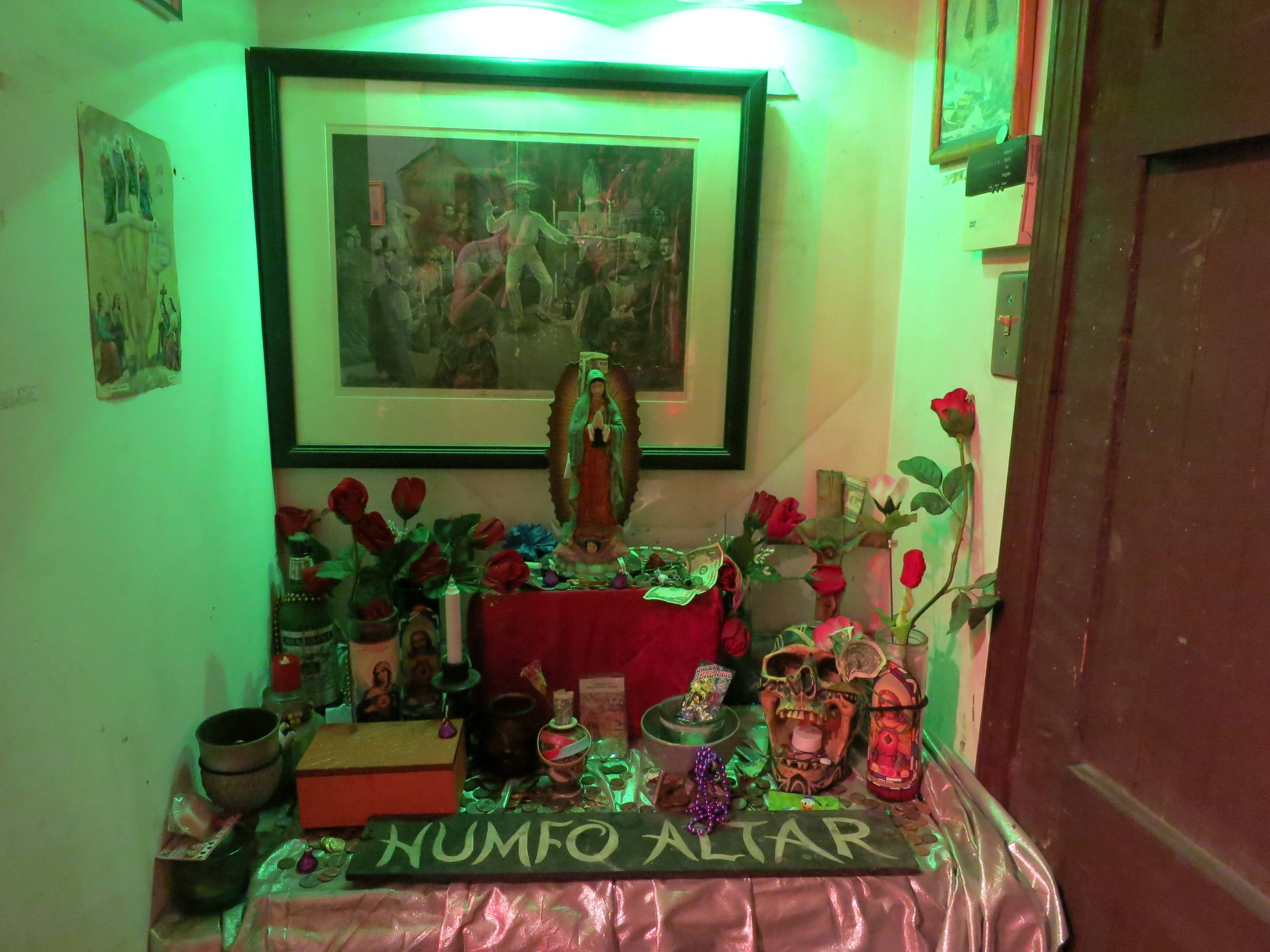
Spiritual Messages and Paintings and Spiritual Tales books are now available on Amazon.

Spiritual altar meaning, spiritual altar meaning
Click below and views more than 600 pieces of spiritual artwork

Spiritual Books
If you enjoy the articles on this website, you will also appreciate the short stories in the books below. Click here and continue the journey.



